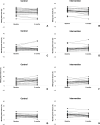Are there compensatory behaviors in response to a sit-stand desk intervention?
- PMID: 39479932
- PMCID: PMC11635982
- DOI: 10.1093/joccuh/uiae067
Are there compensatory behaviors in response to a sit-stand desk intervention?
Abstract
Objectives: Office workers represent one of the most sedentary groups. Alarmingly, more than one-third of their sitting time during workdays occurs in prolonged bouts. Sit-stand desk (SSD) interventions have been found to be effective in reducing sitting time, but heterogeneity exists amongst studies, which may be due to compensations outside the workplace. This study aimed to assess the impact of a 6-month SSD intervention on office workers' sitting and standing times during the work shift and outside work (leisure time).
Methods: A 2-arm (1:1) clustered randomized controlled trial was conducted with 38 participants randomly assigned to either the intervention or control group. The intervention included a psychoeducational session, motivational prompts, and environmental modification (SSD implemented in the workplace). The waiting-list control group maintained the usual work conditions and only received the initial session. We employed repeated measures analysis of covariance to compare changes between groups while adjusting for relevant covariates, with significance set at 5%.
Results: In the intervention group, there was a significant reduction in sitting time at work by 32.97 minutes, along with a notable increase in standing time by 27.88 minutes (P < .05). Although nonsignificant (P > .05), there was an increase in sitting time in the leisure context of about 23.07 minutes.
Conclusions: This study underscores the effectiveness of SSD as a key strategy to mitigate sitting time among office workers. However, future interventions should consider integrating comprehensive behavioral strategies beyond the workplace to sustain potential increases in sitting time during leisure time and avoid compensatory behaviors.
Keywords: compensatory behavior; interindividual variability; sedentary behavior; standing desk; work setting.
© The Author(s) 2024. Published by Oxford University Press on behalf of Journal of Occupational Health.
Conflict of interest statement
The authors declare that they have no competing interests.
Figures
Similar articles
-
What if You Let Them Stand? A 2-Year Follow-up on Sit-Stand Desk.J Occup Environ Med. 2025 Aug 1;67(8):674-683. doi: 10.1097/JOM.0000000000003438. Epub 2025 Apr 28. J Occup Environ Med. 2025. PMID: 40335444
-
The Impact of Sit-Stand Desks on Full-Day and Work-Based Sedentary Behavior of Office Workers: A Systematic Review.Hum Factors. 2025 Jul;67(7):695-713. doi: 10.1177/00187208241305591. Epub 2024 Dec 3. Hum Factors. 2025. PMID: 39626101
-
A multicomponent intervention to reduce daily sitting time in office workers: the SMART Work & Life three-arm cluster RCT.Public Health Res (Southampt). 2023 Sep;11(6):1-229. doi: 10.3310/DNYC2141. Public Health Res (Southampt). 2023. PMID: 37786938 Clinical Trial.
-
The effectiveness of a 6-month intervention with sit-stand workstation in office workers: Results from the SUFHA cluster randomized controlled trial.Work. 2024;79(2):879-890. doi: 10.3233/WOR-230624. Work. 2024. PMID: 38669507 Free PMC article. Clinical Trial.
-
Workplace interventions for reducing sitting at work.Cochrane Database Syst Rev. 2018 Dec 17;12(12):CD010912. doi: 10.1002/14651858.CD010912.pub5. Cochrane Database Syst Rev. 2018. PMID: 30556590 Free PMC article.
References
-
- Ekelund U, Brown WJ, Steene-Johannessen J, et al. . Do the associations of sedentary behaviour with cardiovascular disease mortality and cancer mortality differ by physical activity level? A systematic review and harmonised meta-analysis of data from 850 060 participants. Br J Sports Med. 2019;53(14):886-894. 10.1136/bjsports-2017-098963 - DOI - PubMed
Publication types
MeSH terms
Grants and funding
LinkOut - more resources
Full Text Sources
Medical


